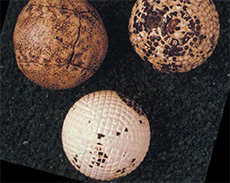We had quite a few correct guesses for our February’s What Is It! We think everyone is already dreaming of getting on the links. Yes, they are old golf balls! These golf balls tell the history of golf. A pre-1850 leather-covered featherie is at left, a guttie, used between 1845 and 1900 is at right. And a rubber ball (bottom) made around 1900 resembles the modern type.
The names given the balls derive from the materials used in them. For example to make a featherie, a ball maker first filled a top hat with loose goose feathers to get the prescribed amount of stuffing. Then he boiled them and stuffed the wet, compacted mess into a pouch of seamed leather strips. When all the feathers were packed, the ball maker sewed up the last seam. After the feathers dried, the sphere became as hard as well, as a golf ball. The leather cover cut easily, so pre-1850 golfers usually swept the ball off the turf rather than hit it, using slim, light, wooden-headed clubs, or woods. Before 1850 few iron-headed clubs existed.
Congratulations to Bill McLaren, Anchorage, Alaska; Dennis Grieser of Brainerd, MN; Judy Hess of Greeley, Colorado; Jacque Rutledge of Northglenn, Colorado; Kay Chambers of Larkspur, Colorado; Carol Klomp of Boulder, Colorado; Theresa Cimino of Middletown, New Jersey (Theresa tells us she saw similar golf balls displayed at the Golf Museum in Far Hills, New Jersey); and Vicky Kellen of Castle Pines, Colorado (Vicky writes, “My dad was a true aficionado, and often spoke of golf history. I looked these balls up and found that they were introduced in 1848 (the year) of Wisconsin’s statehood) by Rev. Dr. Robert Adams and were created from the driest sap of the sapodilla tree which had a rubber-like feel and was formed into balls by heating them up and shaping them while hot.” Thank you, Vicky, for that additional information). You have all won a year’s subscription to the Mountain States Collector.
















Follow Us